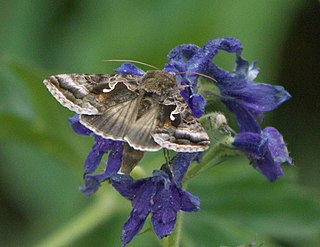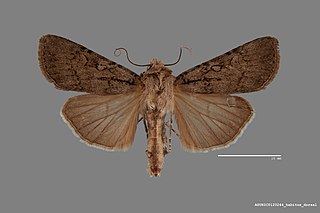
Euxoa tronellus is a moth of the family Noctuidae first described by Smith in 1903. It is found in western North America from western North Dakota and South Dakota, west across southern Saskatchewan and southeastern Alberta to Washington, south to southern California and northern New Mexico.
Abagrotis nanalis is a moth of the family Noctuidae first described by Augustus Radcliffe Grote in 1881. It is found in North America from southern British Columbia east to southwest Saskatchewan and western North Dakota, south to northern New Mexico and California.
Abagrotis vittifrons is a moth of the family Noctuidae first described by Augustus Radcliffe Grote in 1864. It is found in North America from eastern North Dakota and south-western Saskatchewan west to the southern interior of British Columbia, south to southern California, Arizona and New Mexico.

Catocala meskei, or Meske's underwing, is a moth of the family Erebidae. The species was first described by Augustus Radcliffe Grote in 1873. It is found in North America from Maine and Quebec west to southern Alberta and Montana, south to South Carolina in the east and at least Montana in the west.

Autographa pseudogamma, the delicate silver Y, is a moth of the family Noctuidae. The species was first described by Augustus Radcliffe Grote in 1875. It is found in North America from Newfoundland to coastal northern Alaska, south in the east to New England and in the western mountains to New Mexico, Arizona and California. It is also found in the Cypress Hills and the Black Hills of South Dakota.

Euxoa catenula is a species of moth of the family Noctuidae first described by Augustus Radcliffe Grote in 1879. It is found in North America from southern Saskatchewan west to southern Vancouver Island, south to Kansas, New Mexico, Arizona and southern California.

Euxoa mimallonis is a species of moth of the family Noctuidae first described by Smith in 1890. It is found in North America from Nova Scotia west to coastal British Columbia, south in the east to Michigan and Minnesota, in the west to central California and New Mexico.

Schinia nuchalis, the spotted sage moth, is a moth of the family Noctuidae. The species was first described by Augustus Radcliffe Grote in 1878. It is found from the Great Plains and Great Basin, from southern Saskatchewan, Alberta and British Columbia south to northern Arizona. The Eurasian Schinia scutosa is no longer considered a synonym of Schinia nuchalis.
Euxoa campestris, the flat dart, is a moth of the family Noctuidae. The species was first described by Augustus Radcliffe Grote in 1875. It is found in North America from Newfoundland to Alaska, south to New England and southern Canada from southern Quebec west to British Columbia. In the west it is distributed southward in the Rocky Mountains to southern New Mexico, east-central Arizona, and central Utah. In the east it occurs in the Appalachians in eastern Kentucky and in western North Carolina.
Euxoa bochus is a moth of the family Noctuidae first described by Herbert Knowles Morrison in 1874. It is found in western North America, from Vancouver Island, south to southern Utah and northern New Mexico, east to central Colorado, Wyoming and the Cypress Hills area of south-western Saskatchewan. It is also present in Manitoba and British Columbia.

Euxoa albipennis is a moth of the family Noctuidae first described by Augustus Radcliffe Grote in 1876. It is found from coast to coast in southern Canada and the northern parts of the United States, ranging southward in the west to New Mexico, Arizona and California.
Euxoa atomaris is a moth of the family Noctuidae first described by Smith in 1890. It is found in North America from North Dakota, southern Alberta and British Columbia, south to central New Mexico, Arizona and southern California.
Euxoa auripennis is a moth of the family Noctuidae first described by J. Donald Lafontaine in 1974. It is found in western North America from eastern North Dakota and south-western Manitoba west to central British Columbia, south to southern California and Colorado.
Euxoa castanea is a moth of the family Noctuidae first described by J. Donald Lafontaine in 1981. It is found in North America from the North Dakota, South Dakota and south-western Manitoba west to central western British Columbia, north to the Northwest Territories and south in the mountains to Arizona and New Mexico.

Euxoa choris is a moth of the family Noctuidae first described by Leon F. Harvey in 1876. It is found in North America from south-western Saskatchewan, central Alberta and south-central Yukon, south to New Mexico, Arizona and California.
Euxoa cicatricosa is a moth of the family Noctuidae first described by Augustus Radcliffe Grote and Coleman Townsend Robinson in 1865. It is found in North America from south central Saskatchewan west to southern interior British Columbia; south to southern California, Arizona, New Mexico and western Texas; east to western Nebraska and North Dakota.
Euxoa clausa is a moth of the family Noctuidae first described by James Halliday McDunnough in 1923. It is known in North America mainly from the north-western Great Plains in southern Saskatchewan and Alberta, south to south-western Montana and Nebraska.
Euxoa comosa, the hairy euxoa moth, is a moth of the family Noctuidae first described by Herbert Knowles Morrison in 1876. It is found in western North America, except the Pacific coast, ranging east through the northern Great Plains, and in the Hudsonian zone to the Atlantic Ocean. It is found in every province and territory of Canada, except Nunavut.
Euxoa dargo is a moth of the family Noctuidae first described by Strecker in 1898. It is found in North America from south-eastern Manitoba west to the southern interior of British Columbia, south to Oregon, southern Idaho and northern New Mexico, and east to eastern South Dakota.

Euxoa edictalis is a moth of the family Noctuidae first described by Smith in 1893. It is found in North America from south central Alberta and east-central Montana, west to south-central British Columbia, south to central California, southern Nevada, central Utah and western Colorado.





